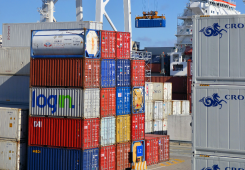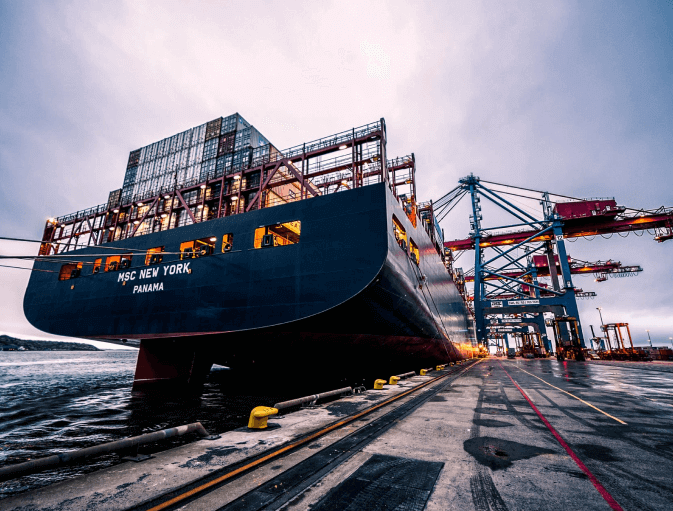Edmonton Shipping Containers – Intermodal Container Dimensions
Dimensions of shipping containers – internal & external height, width, and length. Cubic volume and weight capacity information.


Shipping Container Dimensions And Specifications
Shipping container dimensions and specifications are held to very specific standards by the International Standard for Organization (ISO). This ensures that all containers can be stacked on container ships without issue. Containers are most commonly built in 20′ and 40′ lengths, with standard containers having an outside height of 8’6″ and “High-Cube” containers having an exterior height of 9’6″. The average container is 8’0″ wide and 8’6″ tall. However, there are also “High Cube” containers, which are most common in 40′ lengths and are a foot taller at 9’6″. Shipping container dimensions and specifications are essential when deciding what size container you need for your shipping needs.
Shipping Containers – A Brief History
Shipping containers: the unsung heroes of the cargo world. They’ve been around for centuries, but only recently have they become their own. Let’s look at their history and see why they’re so important.
Early 20th-century shipping was plagued with inefficiencies. Cargo was loaded onto ships piece by piece, a time-consuming and labor-intensive process. Then, during the Korean War, the US military developed the “Container Express” system to transport supplies more efficiently. The term “Conex” comes from that system and is still used today to refer to shipping containers.

More Information About Shipping Containers
Shipping containers come in all shapes and sizes but are held to rigorous specifications and dimensions. That’s because the last thing you want is for your precious cargo to be mishandled at the port. So whether you need a 20-foot container or a 40-foot one, you can trust that our containers will meet your needs while keeping your belongings safe and sound.
Safe Handling Requirements
CSC Plate
When handling a shipping container, knowing the different types and what each type means is essential. One such type is the High Cube container. These containers are one foot taller than standard shipping containers and have yellow decals at the top of the frame on each end to make the extended height more noticeable. High Cube containers are used to transport taller cargo, and it is vital to use the proper handling equipment when loading and unloading these containers. Another type of container is the hazardous cargo container. These containers transport dangerous goods and must be handled with care. There are also labels on these containers that identify the contents as hazardous. It is important to follow the proper procedures when handling these types of containers to ensure the safety of everyone involved.
Handles & Locking Rods
When handling a shipping container, knowing the different types and what each type means is essential. One such type is the High Cube container. These containers are one foot taller than standard shipping containers and have yellow decals at the top of the frame on each end to make the extended height more noticeable. High Cube containers are used to transport taller cargo, and it is vital to use the proper handling equipment when loading and unloading these containers. Another type of container is the hazardous cargo container. These containers transport dangerous goods and must be handled with care. There are also labels on these containers that identify the contents as hazardous. It is important to follow the proper procedures when handling these types of containers to ensure the safety of everyone involved.
Paint & Rust
When handling a shipping container, knowing the different types and what each type means is essential. One such type is the High Cube container. These containers are one foot taller than standard shipping containers and have yellow decals at the top of the frame on each end to make the extended height more noticeable. High Cube containers are used to transport taller cargo, and it is vital to use the proper handling equipment when loading and unloading these containers. Another type of container is the hazardous cargo container. These containers transport dangerous goods and must be handled with care. There are also labels on these containers that identify the contents as hazardous. It is important to follow the proper procedures when handling these types of containers to ensure the safety of everyone involved.
Container Identification Number
When handling a shipping container, knowing the different types and what each type means is essential. One such type is the High Cube container. These containers are one foot taller than standard shipping containers and have yellow decals at the top of the frame on each end to make the extended height more noticeable. High Cube containers are used to transport taller cargo, and it is vital to use the proper handling equipment when loading and unloading these containers. Another type of container is the hazardous cargo container. These containers transport dangerous goods and must be handled with care. There are also labels on these containers that identify the contents as hazardous. It is important to follow the proper procedures when handling these types of containers to ensure the safety of everyone involved.
Size and Capacity Specifications
When handling a shipping container, knowing the different types and what each type means is essential. One such type is the High Cube container. These containers are one foot taller than standard shipping containers and have yellow decals at the top of the frame on each end to make the extended height more noticeable. High Cube containers are used to transport taller cargo, and it is vital to use the proper handling equipment when loading and unloading these containers. Another type of container is the hazardous cargo container. These containers transport dangerous goods and must be handled with care. There are also labels on these containers that identify the contents as hazardous. It is important to follow the proper procedures when handling these types of containers to ensure the safety of everyone involved.
Rubber Door Gasket
When handling a shipping container, knowing the different types and what each type means is essential. One such type is the High Cube container. These containers are one foot taller than standard shipping containers and have yellow decals at the top of the frame on each end to make the extended height more noticeable. High Cube containers are used to transport taller cargo, and it is vital to use the proper handling equipment when loading and unloading these containers. Another type of container is the hazardous cargo container. These containers transport dangerous goods and must be handled with care. There are also labels on these containers that identify the contents as hazardous. It is important to follow the proper procedures when handling these types of containers to ensure the safety of everyone involved.
